
An action potential occurs when the membrane potential of a specific cell rapidly rises and falls. This depolarization then causes adjacent locations to similarly depolarize. Action potentials occur in several types of animal cells, called excitable cells, which include neurons, muscle cells, and in some plant cells. Certain endocrine cells such as pancreatic beta cells, and certain cells of the anterior pituitary gland are also excitable cells.
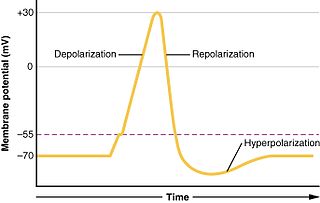
In biology, depolarization or hypopolarization is a change within a cell, during which the cell undergoes a shift in electric charge distribution, resulting in less negative charge inside the cell compared to the outside. Depolarization is essential to the function of many cells, communication between cells, and the overall physiology of an organism.

The lateral line, also called the lateral line organ (LLO), is a system of sensory organs found in fish, used to detect movement, vibration, and pressure gradients in the surrounding water. The sensory ability is achieved via modified epithelial cells, known as hair cells, which respond to displacement caused by motion and transduce these signals into electrical impulses via excitatory synapses. Lateral lines serve an important role in schooling behavior, predation, and orientation.

In physiology, a stimulus is a detectable change in the physical or chemical structure of an organism's internal or external environment. The ability of an organism or organ to detect external stimuli, so that an appropriate reaction can be made, is called sensitivity (excitability). Sensory receptors can receive information from outside the body, as in touch receptors found in the skin or light receptors in the eye, as well as from inside the body, as in chemoreceptors and mechanoreceptors. When a stimulus is detected by a sensory receptor, it can elicit a reflex via stimulus transduction. An internal stimulus is often the first component of a homeostatic control system. External stimuli are capable of producing systemic responses throughout the body, as in the fight-or-flight response. In order for a stimulus to be detected with high probability, its level of strength must exceed the absolute threshold; if a signal does reach threshold, the information is transmitted to the central nervous system (CNS), where it is integrated and a decision on how to react is made. Although stimuli commonly cause the body to respond, it is the CNS that finally determines whether a signal causes a reaction or not.
The adequate stimulus is a property of a sensory receptor that determines the type of energy to which a sensory receptor responds with the initiation of sensory transduction. Sensory receptor are specialized to respond to certain types of stimuli. The adequate stimulus is the amount and type of energy required to stimulate a specific sensory organ.
A mechanoreceptor, also called mechanoceptor, is a sensory receptor that responds to mechanical pressure or distortion. Mechanoreceptors are innervated by sensory neurons that convert mechanical pressure into electrical signals that, in animals, are sent to the central nervous system.

Sensory neurons, also known as afferent neurons, are neurons in the nervous system, that convert a specific type of stimulus, via their receptors, into action potentials or graded potentials. This process is called sensory transduction. The cell bodies of the sensory neurons are located in the dorsal ganglia of the spinal cord.

The Pacinian corpuscle, lamellar corpuscle or Vater-Pacini corpuscle is one of the four major types of mechanoreceptors found in mammalian skin. This type of mechanoreceptor is found in both glabrous (hairless) and hirsute (hairy) skins, viscera, joints and attached to periosteum of bone, primarily responsible for sensitivity to vibration. Few of them are also sensitive to quasi-static or low frequency pressure stimulus. Most of them respond only to sudden disturbances and are especially sensitive to vibration of few hundreds of Hz. The vibrational role may be used for detecting surface texture, e.g., rough vs. smooth. Most of the Pacinian corpuscles act as rapidly adapting mechanoreceptors. Groups of corpuscles respond to pressure changes, e.g. on grasping or releasing an object.
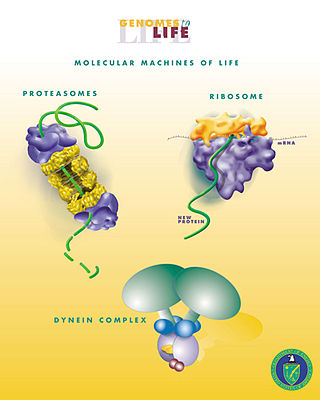
In cellular biology, mechanotransduction is any of various mechanisms by which cells convert mechanical stimulus into electrochemical activity. This form of sensory transduction is responsible for a number of senses and physiological processes in the body, including proprioception, touch, balance, and hearing. The basic mechanism of mechanotransduction involves converting mechanical signals into electrical or chemical signals.
Merkel nerve endings are mechanoreceptors, a type of sensory receptor, that are found in the basal epidermis and hair follicles. They are nerve endings and provide information on mechanical pressure, position, and deep static touch features, such as shapes and edges.
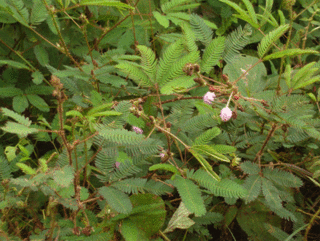
In biology, thigmonasty or seismonasty is the nastic (non-directional) response of a plant or fungus to touch or vibration. Conspicuous examples of thigmonasty include many species in the leguminous subfamily Mimosoideae, active carnivorous plants such as Dionaea and a wide range of pollination mechanisms.
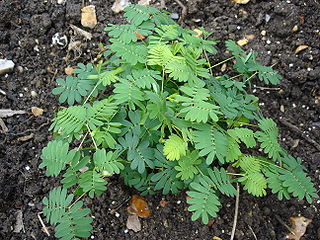
Plant perception is the ability of plants to sense and respond to the environment by adjusting their morphology and physiology. Botanical research has revealed that plants are capable of reacting to a broad range of stimuli, including chemicals, gravity, light, moisture, infections, temperature, oxygen and carbon dioxide concentrations, parasite infestation, disease, physical disruption, sound, and touch. The scientific study of plant perception is informed by numerous disciplines, such as plant physiology, ecology, and molecular biology.
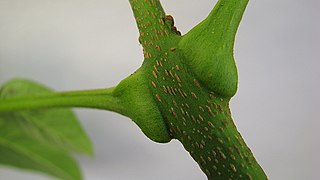
A pulvinus is a joint-like thickening at the base of a plant leaf or leaflet that facilitates growth-independent movement. Pulvini are common, for example, in members of the bean family Fabaceae (Leguminosae) and the prayer plant family Marantaceae.
Mechanosensation is the transduction of mechanical stimuli into neural signals. Mechanosensation provides the basis for the senses of light touch, hearing, proprioception, and pain. Mechanoreceptors found in the skin, called cutaneous mechanoreceptors, are responsible for the sense of touch. Tiny cells in the inner ear, called hair cells, are responsible for hearing and balance. States of neuropathic pain, such as hyperalgesia and allodynia, are also directly related to mechanosensation. A wide array of elements are involved in the process of mechanosensation, many of which are still not fully understood.
Mechanosensitive channels (MSCs), mechanosensitive ion channels or stretch-gated ion channels are membrane proteins capable of responding to mechanical stress over a wide dynamic range of external mechanical stimuli. They are present in the membranes of organisms from the three domains of life: bacteria, archaea, and eukarya. They are the sensors for a number of systems including the senses of touch, hearing and balance, as well as participating in cardiovascular regulation and osmotic homeostasis (e.g. thirst). The channels vary in selectivity for the permeating ions from nonselective between anions and cations in bacteria, to cation selective allowing passage Ca2+, K+ and Na+ in eukaryotes, and highly selective K+ channels in bacteria and eukaryotes.
A sense is a biological system used by an organism for sensation, the process of gathering information about the world through the detection of stimuli. Although in some cultures five human senses were traditionally identified as such, it is now recognized that there are many more. Senses used by non-human organisms are even greater in variety and number. During sensation, sense organs collect various stimuli for transduction, meaning transformation into a form that can be understood by the brain. Sensation and perception are fundamental to nearly every aspect of an organism's cognition, behavior and thought.
Electrocochleography is a technique of recording electrical potentials generated in the inner ear and auditory nerve in response to sound stimulation, using an electrode placed in the ear canal or tympanic membrane. The test is performed by an otologist or audiologist with specialized training, and is used for detection of elevated inner ear pressure or for the testing and monitoring of inner ear and auditory nerve function during surgery.
Plant bioacoustics refers to the creation of sound waves by plants. Measured sound emissions by plants as well as differential germination rates, growth rates and behavioral modifications in response to sound are well documented. Plants detect neighbors by means other than well-established communicative signals including volatile chemicals, light detection, direct contact and root signaling. Because sound waves travel efficiently through soil and can be produced with minimal energy expenditure, plants may use sound as a means for interpreting their environment and surroundings. Preliminary evidence supports that plants create sound in root tips when cell walls break. Because plant roots respond only to sound waves at frequencies which match waves emitted by the plants themselves, it is likely that plants can receive and transduce sound vibrations into signals to elicit behavioral modifications as a form of below ground communication.
Plants can be exposed to many stress factors such as disease, temperature changes, herbivory, injury and more. Therefore, in order to respond or be ready for any kind of physiological state, they need to develop some sort of system for their survival in the moment and/or for the future. Plant communication encompasses communication using volatile organic compounds, electrical signaling, and common mycorrhizal networks between plants and a host of other organisms such as soil microbes, other plants, animals, insects, and fungi. Plants communicate through a host of volatile organic compounds (VOCs) that can be separated into four broad categories, each the product of distinct chemical pathways: fatty acid derivatives, phenylpropanoids/benzenoids, amino acid derivatives, and terpenoids. Due to the physical/chemical constraints most VOCs are of low molecular mass, are hydrophobic, and have high vapor pressures. The responses of organisms to plant emitted VOCs varies from attracting the predator of a specific herbivore to reduce mechanical damage inflicted on the plant to the induction of chemical defenses of a neighboring plant before it is being attacked. In addition, the host of VOCs emitted varies from plant to plant, where for example, the Venus Fly Trap can emit VOCs to specifically target and attract starved prey. While these VOCs typically lead to increased resistance to herbivory in neighboring plants, there is no clear benefit to the emitting plant in helping nearby plants. As such, whether neighboring plants have evolved the capability to "eavesdrop" or whether there is an unknown tradeoff occurring is subject to much scientific debate. As related to the aspect of meaning-making, the field is also identified as phytosemiotics.
In plant biology, plant memory describes the ability of a plant to retain information from experienced stimuli and respond at a later time. For example, some plants have been observed to raise their leaves synchronously with the rising of the sun. Other plants produce new leaves in the spring after overwintering. Many experiments have been conducted into a plant's capacity for memory, including sensory, short-term, and long-term. The most basic learning and memory functions in animals have been observed in some plant species, and it has been proposed that the development of these basic memory mechanisms may have developed in an early organismal ancestor.










